Valorant Right-Click: A Mathematical Perspective
A lot of buzz has been circulating about the Classic Right-Click. Let’s look at it from a new lens: What is randomness, and what does it say about how the RNG of the Classic should work.
A lot of buzz has been circulating about the Classic Right-Click. Let’s look at it from a new lens: What is randomness, and what does it say about how the RNG of the Classic should work.
We’ve all had those moments. We are in a game, we scare an enemy around a corner, we swing to finish the kill and *bang*, the Classic right-click deletes our entire existence. The Classic’s right-click has been the subject of controversy in the VALORANT scene for some time, in both the casual and pro scene. Its ease of use relative to its lack of price has made many question its role in the game, and more recently, its necessity. Does VALORANT really need the Classic right-click in its current state?
To begin, let’s have a quick discussion of the root of the problem, and how it can be misconstrued. This is a concept that, despite its relatively simple nature, has plagued mathematics since the very concept of decision-making came into being (Peterson xi). For a long time, randomness/chance was viewed as “merely ignorance of initial conditions (153 Bennett).” However, over time, several mathematicians suggested that randomness was not from lack of knowledge, instead, it was uncertainty. Specifically, it has no exceptional properties and it is hard to describe (102 Nies).
Another way to describe it is to consider a bucket that gets filled with 6 different colors of balls. If the phenomenon was random, one would have trouble describing how the balls are falling into the bucket (hard to describe). In addition, what color is picked does not affect the next. I could have 10 red balls fall into the bucket one right after the other, or I could have no red balls in 10 drops. There is no true pattern to randomness - there are no exceptional properties.
This is not a doctoral thesis, so I will save you the massive logical arguments and proofs. Simply put, the current mathematical thinking of randomness is the lack of pattern in occurrence. Just because it may seem to have a pattern doesn't mean it can be predicted. We can only view randomness after it has passed, not before. In the long run, a pattern may come to light, but if one was to repeat the experiment, the pattern could easily fall apart.
This is important to note. True randomness is complete ignorance of what has come before it. The past choice does not affect the present, which, in turn, does not determine or predict the future. Video games are different, they do not have true randomness. Many games use a type of pseudo-randomness based on “random number generators” or RNG. It creates, seemingly, random occurrences to mimic the feel of unpredictability. But, by definition, RNG is not truly random, it just FEELS random.
I would say that the right-click is overpowered. Obviously, you will run into RNG where it is not amazing. You can be moving, you can be shooting… the jump-click is super reliable.
Many games benefit from some form of uncertainty. Think of grinding resource games, where you have to grind a dungeon to have a chance to get an item, which forces a player to play the game more. Games like Pokémon have accuracy and random number multipliers on the damage outputted, making battles more intense. World building games like Minecraft use layers of RNG to make unique landscapes and geography. Some games even capitalize on RNG, mainly gacha games like Genshin Impact or Cookie Run Kingdom. While RNG can be infuriating, when done well, it can make a game more engaging and make a desirable outcome feel rewarding.
So why should you care? Well, RNG is an aspect to gunplay in VALORANT. Every bullet shot is impacted by some form of this controlled randomness. With aspects such as spread, jumping inaccuracy, and recoil added into the mix, uncertainty becomes a player’s worst nightmare. This is why players practice counter-strafing, or slowly moving their mouse down to counteract the recoil of a Phantom spray: this minimizes the RNG, which minimizes the uncertainty of a shot, which maximizes the potential to get a kill (which is the point of shooting in the first place).
With this being said, RNG is not unhealthy for VALORANT. If some form of chance was not present, gunplay would be stagnant. RNG adds a level of skill to many weapons, and a player’s ability to minimize the uncertainty quickly is a hallmark of a player’s consistency. RNG also keeps guns from doing things they are not supposed to. A Vandal becomes inaccurate if you don’t practice burst firing, a shotgun’s spray becomes sporadic and less powerful if you shoot someone who is far away, and a Sheriff is a gamble if you don’t practice the recoil reset timing. RNG as a punishment for not understanding the basic mechanics of the game is not unhealthy. While it can be infuriating to play against, if a player with good spray control encounters a running and gunning Phantom player, the idea is that the person with better spray control will, most of the time, win.
For me the right click is too precise and accurate. I think either changing it so there is a greater spread (less precision), would help with the scenarios where people get 1 bursted, but I think the other pistols need a rework as well even with the right click nerf... Just seems ridiculous that (if) a right click (hits) 2 of the bullets hit the head it does like 156 damage.
The main aspect of RNG is that, in general, it’s supposed to feel fair. Consider flipping a fair coin. We may get 3 or 4 heads in a row, but we know that getting a head or a tail is 50%. With RNG, things with low percentages will take some time to acquire, while common items will pop up more and more frequently. Fairness and randomness have this unspoken agreement with each other. Problems arise when this agreement is violated.
An enemy who has a chance to one-shot someone can feel very unfair if a string of kills occurs. Grinding for hours upon end and getting nothing from it is painful. Referencing the gun example from before, the few times the run and gun duelist lands a completely random headshot is incredibly unsatisfying and feels unfair.This is the two-faced nature of RNG, what it gives, it can also take away. But this is just a blimp in the nature of randomness.
Unhealthy RNG occurs when an event not only feels unfair, but also breaks the sense of randomness, flying in the face of the fundamentals of the game. This is when the RNG aspect needs to be changed.
Imagine a game where you grind items to affect stats, analyze type matchups, and learn who has the best magic or physical attack, you then encounter a boss who has a low chance of using a one-hit kill move, and just so happens to kill your healer. That is bad RNG: it feels unfair, it feels targeted, and flies in the face of a game that values grinding and planning.
A more VALORANT example: The Pre-2.03 Stinger. Players would buy a Stinger for its cheapness and easy effectiveness to kill high health targets on an econ round. It had a quick and easy burst, coupled with little recoil and little fall-off damage. It didn’t matter that the bullets did little damage, it took 6 bullets to fly before massive recoil came into play. 4 bullets to the body would kill a fully armored target, and that was if no headshots landed. This was also Pre-Patch 3.0, before walking and running inaccuracy was implemented, so zooming around a corner to slam an opponent was not unheard of (even if it did have some inaccuracy).
This is, again, an example of bad RNG. It felt unfair, because a gun costing 1000 credits could swing around corners and kill enemies quickly. While it was technically random, it felt as though the gun didn’t have any RNG at all, as the spread and fire rate was not high enough to increase the uncertainty and inaccuracy of its spray. And it flew in the face of the “intended” purpose of the game, better gunplay is supposed to win.
So many things in the game aren’t skill-based, one major thing is the Classic Right-Click. It doesn’t belong… You can one-burst someone while not really aiming at them and in a completely inaccurate state. It’s unwinnable at low health… cause you have no chance to headshot them when they are jumping out and right-clicking you. Oh and it’s a free gun burst.
And thus, we arrive at the Classic, probably one of the most controversial guns in the game. Some are indifferent to it, but others scream to “Get it out of the game”. And it is really easy to see that the Classic right-click is an example of bad RNG:
1. It feels unfair, both to the people who use it and the people who die from it
2. The sense of randomness is gone, as kills happen more frequently then they feel like they should.
3. It flies in the face of intended game design, as a free gun is able to kill a 150-health player in one careless hit.
But just how bad is it? Is it a fringe case, or is it more prevalent than one realizes? The best way to show this, I feel, is visual. Now, agent heights are not actually common knowledge, Riot has not released the in-game heights for the agent. So, for calculations, I used this Reddit post by u/Stark002002 that puts them at 1.98 m (6’6”) tall. Obviously, that is really large. However, that is pretty close to when I did similar calculations, and in-game height does not reflect the real height of characters (as height difference could leave to tactical advantage), so it’s not out of the realm of possibility. Also, I could not find the running inaccuracies for the regular shotguns, so made these spreads with the estimate of a 0.75 inaccuracy estimate. If it’s bigger, then simply imagine the spreads of the shotguns being larger.
Here are all the Classic spreads. It goes 10m away, then 15m, 20m then 25m.
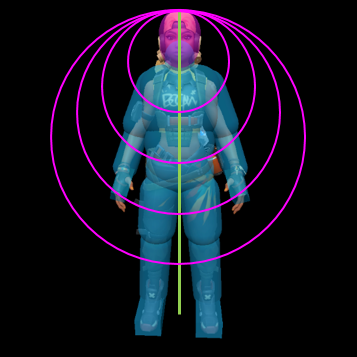
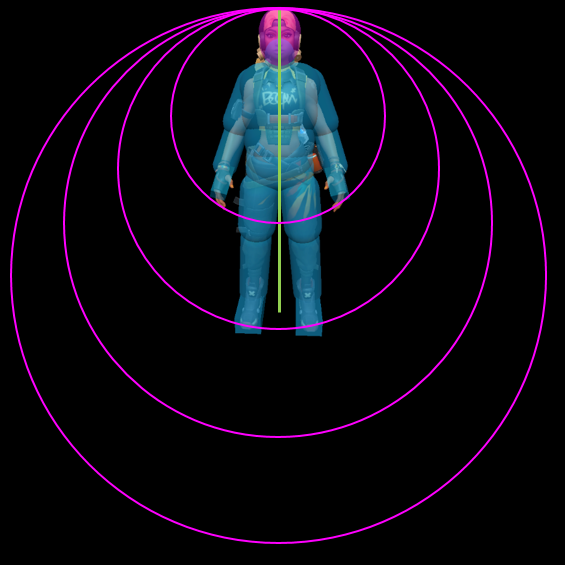
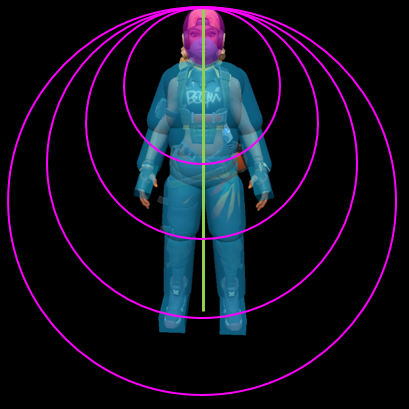
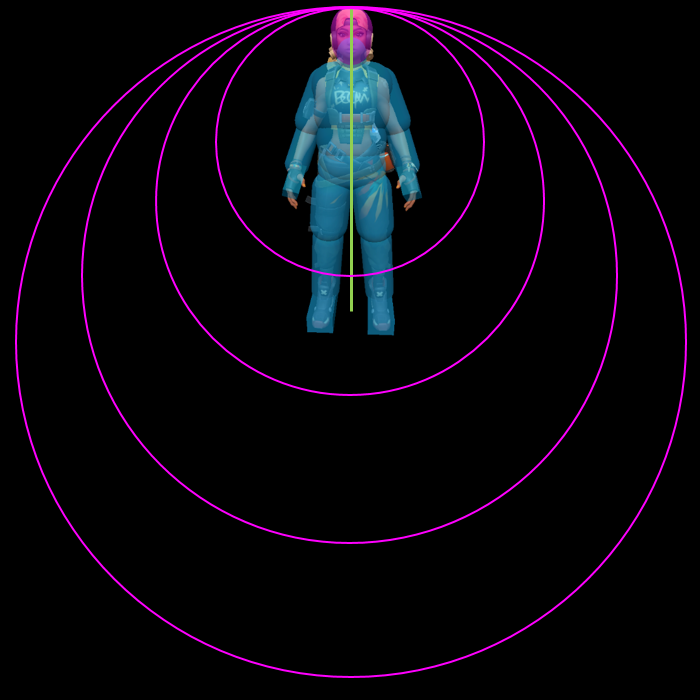
Now, below is the Classic’s spread compared to when you do something similar with the Shorty, Bucky and Judge (Running compared to Running, etc.). The following photos are the gun spreads for each shotgun in the game, color coded with the following scheme: Pink – Classic Right-Click, Orange – Shorty, Blue – Bucky, Yellow – Judge. I wanted to highlight the spread in comparison to hitboxes in Valorant.
As you can see, the perspective is a bit distorted, so the green line shows the general height of an agent in-game.
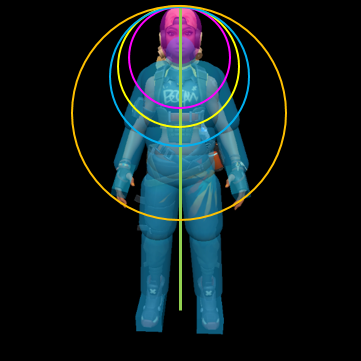
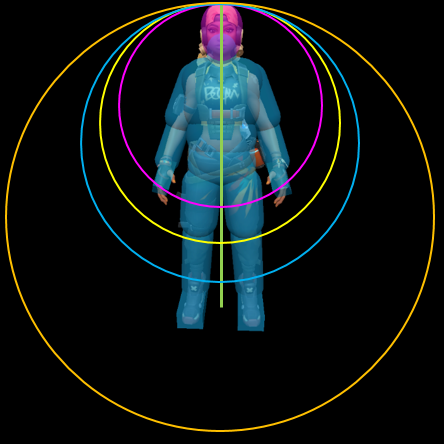

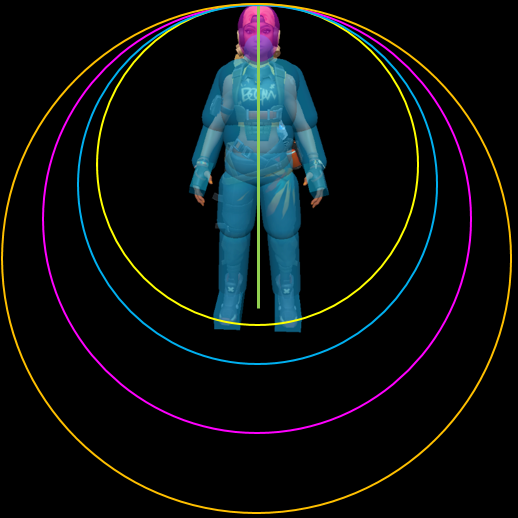
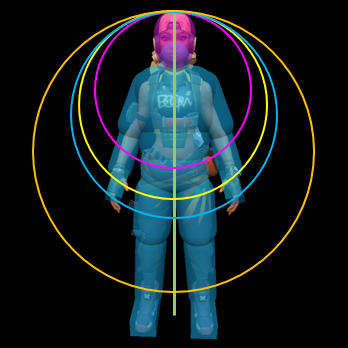
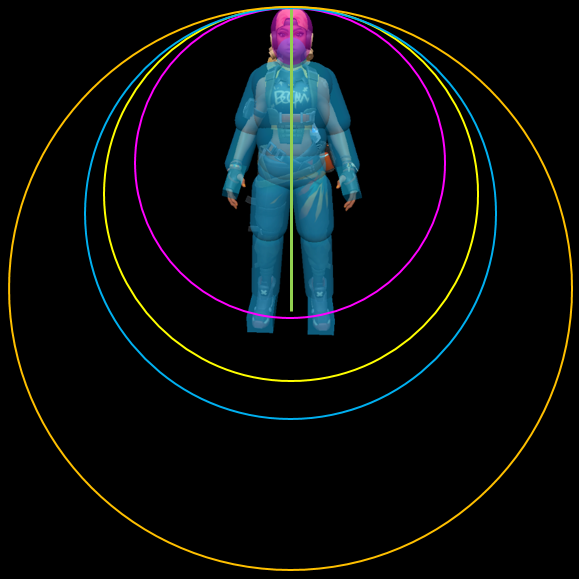
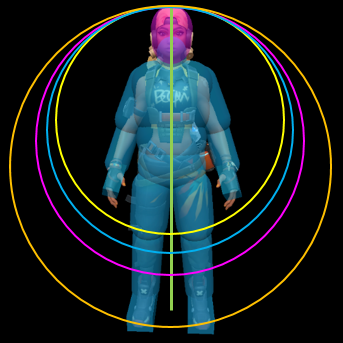
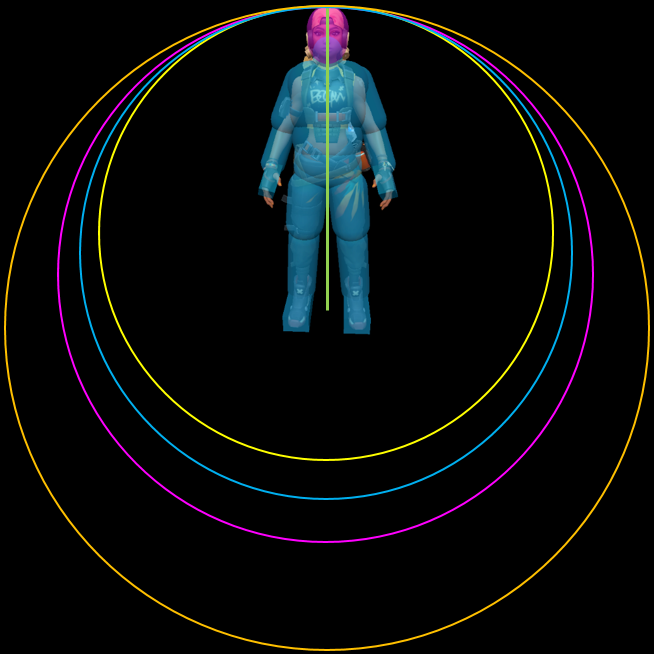
Why did I choose 10m and 20m? 10m is around the area where the Shorty and Bucky start to have fall-off damage. 20m is the farthest edge of the shotgun edge for all three main shotgun weapons. However, just to note, the Classic has no fall-off damage on the right-click until it reaches 30m.
1. If I have to compare the Classic right-click to an 850 credit and 1850 credit gun to show it has limitations, we have a problem already. I have to compare it to guns that cost money in order to put some “cap” on its power. That’s a problem.
2. The right-click damage makes no sense logically: It has the headshot multiplier and falloff of a non-shotgun, but the spray and fire rate of a shotgun. It does have inaccuracy, but that inaccuracy is still better than the Shorty, Bucky and Judge. If you pay for more damage, less spray, and more consistent kills, shouldn’t it go Classic < Shorty < Bucky < Judge?
3. Its intended purpose is to kill low health targets, put a dent in enemies rushing you, or catch someone by surprise on a pistol round. It should be okay at killing 100 health targets, and killing someone with light armor should be rare. But the fact that someone can jump over a box like a goat and right click a full health armored target is not in its intended purpose. That’s the job of a proper shotgun. So it’s doing more than its intended purpose.
4. In the examples above, the Classic beats out the Shorty unless you are full-sprint jumping. However, unlike the Shorty, the Classic has no falloff, meaning that, at almost any range, the Classic is more likely to kill a target than a Shorty.
5. Jumping with the Classic adds less inaccuracy than running with it. This means that swinging with the Classic creates more uncertainty than jumping with it. So rather than using tactics like counter-strafing, the Classic encourages players to hide around boxes and jump.
6. While other shotguns send out more bullets, you can’t buy a Bucky or Judge as an off-hand weapon. So the main shotgun pistol competition is the Shorty. The Shorty only does well if you can get really close (such as with Jett or Yoru), so, in general, the Classic out-performs its pistol counterpart.
On a fundamental mathematical level, the right click is too powerful. It should not be left up to RNG to decide whether a full 150 health target lives or dies. One way to fix it is to get rid of it. But what are some ways to change it without deleting it from the game?
1. Change the headshot multiplier: The right-click is a shotgun, not a rifle or a sniper or a SMG or a machine gun. It’s a shotgun. Shotguns have a headshot multiplier of x2 (x2 the damage done to the body). Yet the right-click keeps the left-click’s 3x damage multiplier.
2. Increase all inaccuracies: If we want the progression of better gun being more expensive, then the Classic should be worse. Increasing inaccuracy significantly, particularly jumping and running inaccuracy, would reduce the zoomies alt-firing that we witness frequently.
3. Give the alt-fire falloff: Simple: Why should a free shotgun have the same falloff range as a Ghost and a Sheriff? It shouldn’t, even if it’s highly inaccurate. If we want to use the same reasoning as “better gun implies more expensive”, then the Classic right-click should have falloff starting somewhere before 7m (Shorty’s falloff), probably around 5m. This makes being super close to a Classic dangerous, but after that, not as scary.
4. Reduce the number of pellets to 2: In tandem with the multiplier change above, this would prevent 125 and 150 health targets from being taken down in one hit. The max would be 104 with 2 headshots. Even without any of the above listed, reducing the number of pellets would reduce the chance to kill.
Obviously, doing all the above might be a tad bit much (although I wouldn’t mind). However, some combination of the above would not only reduce the gun’s potency in certain situations, but also would just make more sense from a logical/mathematical standpoint.
Webpages
Reddit post used for height: u/Stark002002, Reply to “Valorant Agents are Very Short,” by u/Putr1k, 1 February 2021. Link
Reddit post use for hitbox visualization: u/Altimor, “Valorant Hitbox Visualization,” 13 April 2020. Link
Books:
Bennett, Deborah J. “Randomness as Uncertainty.” Randomness, Harvard University Press, Cambridge, MA, 1999, pp. 152–161.
Nies, André. “Martin-Löf Randomness and Its Variants.” Computability and Randomness., Oxford University Press, Oxford, 2009, pp. 102–104.
Peterson, Ivars. “Infinite Possibility.” The Jungles of Randomness: A Mathematical Safari, Wiley, New York, 1998, pp. 9–13.